More Films by Edwin S. Porter of the Kinetoscope Era
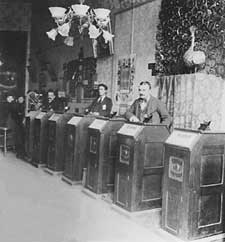 The kinetoscope was existed at Thomas Alva Edison's company by 1891 & it's actual inventor, William K. L. Dickson, was making ultra-short motion pictures on film to test on the equipment. The kinetoscope was existed at Thomas Alva Edison's company by 1891 & it's actual inventor, William K. L. Dickson, was making ultra-short motion pictures on film to test on the equipment.
Apart from a few preliminary exhibitions, in the main the kinetoscope age didn't begin for the public at large until 1894, when the first "kinetoscope parlors" appeared, & when carnivals & fairground exhibitors & park arcades began adding kinetoscopes to their midways.
The first kinetoscopes played twenty-second films, half a minute if you turned the handle a mite slower. Soon there'd be bigger ones that played two-minute films. But each kinetoscope played ony one film & if a customer was going to stay in the parlor or sideshow tent for longer than a minute or two, an entire bank of kinetoscopes was required, each playing a different ultra-short film, or each playing the next chapter or scene or a "long" film though few were ever longer than about ten minutes tops.
The first ones cost a penny, but soon the standard price would be a nickel for a two-minute film. These would wear out in time, & even if they lasted a long time, repeat customers wanted to see something new. Edison's Black Marie studio was kept busy with a growing number of filmmakers producing film after film after film to meet the growing public apetite.
Edwin S. Porter came to work at the Black Maria studio of the Edision Manufacturing Company in 1900, at first as a technician to operate projectors. He very soon began photographing films himself & would become America's first "big name director" -- famous at the latest by the time he made Life of an American Fireman (1903), & cemented his reputation with The Great Train Robbery (1903).
Thomas A. Edison had next to nothing to do with the kinetoscope branch of his enormous research & manufacturing company, having invented neither the hardware to make & exhibit films, nor the films that brought the public working.
Edison was in many ways an unpleasant man despite his carefully controlled public image. He was faithless to even the best men to serve his company well, & would turn against Porter & fire him in 1909, much as he had previously turned against his first great film man in America, William Dickson.
WHen jettisoned by Edison, Porter set out on his own to continue his filmmaking career, but ended up more in the business end than creative end of the industry. So Porter's dominance mainly during those years at the Black Maria studio fulfilling the public's desire for endless varieties of kinetoscopic cinema.
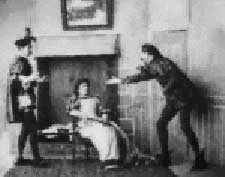 A two minute film in the manner of Georges Melies, Faust & Marguerite (1900) was vaguely based on Goethe, though the touchstones to Goethe are scant.
A two minute film in the manner of Georges Melies, Faust & Marguerite (1900) was vaguely based on Goethe, though the touchstones to Goethe are scant.
Porter, avowedly influenced by Melies' fantasies & trick-films, had obviously seen Melies' own Faust & Marguerite (1897). Though Porter's take is far from original, it was fairly typical that one studio copied others. We may surmise this is a film he really wanted to make this, & perhaps felt he was paying homage to Melies rather than stealing anything.
Faust recieves a sword from Mephistopheles, with Marguerite seated between them. Mephistopheles touches her head & she vanishes & reappears beside the door, while Faust is now in the chair. The devil then touches Faust & the two figures return to their original positions.
At the tap of the sword, the devil turns Faust into a skeleton. Marguerite sits calmly throughout. Mephistopheles for a second time catches her attention when he goes upon his knee before her. But she vanishes from sight, as does the skeleton of Faust.
In the end, Mephistopheles has turned into Faust, Marguerita has reappeared, & a preacher in tophat has appeared in classic deux ex machina to joins the hands of Marguerite & Faust in marriage.
Though wickedly confused as a plotline, it's quite magic-packed, intended as a showcase for camera tricks; a coherent story was distant in importance.
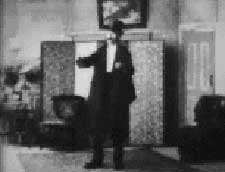 The Black Maria studios was going totally bonkers watching those Georges Melies films from Paris, & put out several Meliesian trick-camera fantasies in 1900.
The Black Maria studios was going totally bonkers watching those Georges Melies films from Paris, & put out several Meliesian trick-camera fantasies in 1900.
The photographers or producers aren't always known, but the films Meliesian films ascribed to Edwin Porter tend to be better, though there's also a lot to be said for J. Stuart Blackton's The Artist's Dilemma (1901).
An example that failed may have been photographed by Albert E. Smith, but some ascribe it to Porter. I hate to think Porter or Blackton were in charge, as The Magician (1900) is one of the unimaginative imitations of Melies. In 1900 Porter was only beginning to show his full genius, not always sustained; so perhaps The Magician is properly ascribed to him.
It uses the easiest trick photography along with Melies' recurring theme of the magician, but this American version reduces the simple to the simpleminded.
A standard-issue magician in tux walks center stage & makes his gloves & hat & jacket disappear. He takes out a hanky, whirls it about, & makes it disappear. He materializes a table & tissue paper & out of the confetti he flings ducks. The end.
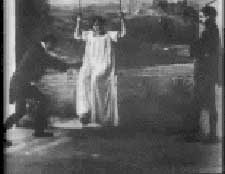 The Magician might've seemed better as a pilot effort to capture the essence of what Melies was doing in Paris, with the expectation of getting better at it. The Magician might've seemed better as a pilot effort to capture the essence of what Melies was doing in Paris, with the expectation of getting better at it.
But Porter was already better at it, & what appears to have been Porter's very first film, The Mystic Swing (1900), really does try to capture the Star Films magic, but without being slavishly imitative or merely inferior.
The Edison catalog identified this devil of The Mystic Swing as Mephisto (also known as Mephistopheles), the very devil who tempted Faust, & indeed he has Mephisto's feathered cap. But the same catalog identifies the man of the tale as "the professor," so presumedly he is not Faust & the girl in the swing is not Marguerite. They constitute, at least, a parallel character array.
A magician (the professor) makes a woman appear on the empty swing, in a long nightdress. Mephisto stands stage right watching, having we may suppose taught the magician this occult art.
Mephisto with a bow vanquishes the maiden in the swing & indicates he would like the magician to do the trick again. This time an older woman appears in the swing, wearing a flouncy dress. Mephisto again bows to make the woman disappear.
On his third attempt, the magician causes a skeleton to materialize on the swing. Apparently all three manifestations were the same woman in youth, maturity, & death. This last Mephisto is unable to vanquish, but the magician himself makes the skeleton vanish, & Mephisto acknowledges the magician's greatness.
Finally the magician makes both actresses reappear, & all four players bow to the audience, then to one another, then again to the audience. I really like this little film quite a bit, as it takes the whimsies of Melies & refashions them as a wee philosophical play.
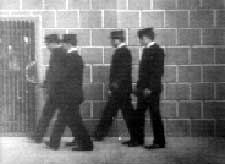 The Execution of Czolgosz, with Panorama of Auburn Prison; aka, Electrocution of Czolgosz (1901) starred actor and set painter George S. Fleming. It was about Leon Czolgosz, the mentally ill assassin who killed President McKinley.
The Execution of Czolgosz, with Panorama of Auburn Prison; aka, Electrocution of Czolgosz (1901) starred actor and set painter George S. Fleming. It was about Leon Czolgosz, the mentally ill assassin who killed President McKinley.
This was a lurid subject. Edwin S. Porter probably would never have chosen on his own, but he was new at Black Maria studios & didn't yet have much weight in project choice.
Thomas A. Edison wanted films of this type specifically because he was in direct competition with Westinghouse, who had popularized the idea of "humane" executions with electricity, & Edison wanted everything associated with electricity stamped in the public mind as his alone, not Westinghouse's or Tesla's or anyone elses.
There are aspects brought to this nasty little film which are perhaps early indicator's of Porter's inevitable leap forward with film art:
The panorama of the actual state prison, its smokestack, the passing train, establishes the setting of the event before the action begins. The camera pans the outer wall, conveying the prison's immensity, then from a higher angle shows associated buildings as though we're getting closer to the characters we're about to see.
All this documentary imagery lends greater authenticity when the film cuts to the interior of the prison which is actually the Black Maria studio with actors. This use of exterior shots to increase interior-shot realism was brilliant for 1901.
Leon is strapped into a chair, the current turned on, & he slumps slightly without the jerking & smoking that would actually have occurred, lending credence to Edison's & Westinghouse's assertions that electricity was a humane method of capital punishment.
More revealing of the inhumane effects of this "wonderful" new means of killing people is when Edisioni arranged for his filmmakers to record for its adveriting merits the act of Electrocuting an Elephant (1903).
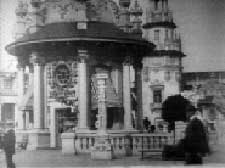 The "panorama" films are very far from my favorites. With rare exceptions (like The Execution of Czolgosz or Rube & Mandy at Coney Island, 1903) they're not films of character or event, but of place.
The "panorama" films are very far from my favorites. With rare exceptions (like The Execution of Czolgosz or Rube & Mandy at Coney Island, 1903) they're not films of character or event, but of place.
It was a type of film Porter obviously liked to make, however, & such films represent the earliest "moving camera" films as opposed to stationary shots.
Circular Panorama of the Electric Tower (1901) provides a 360 degree pan from the north side of the Electric Tower at the Pan-American Exposition. Porter selected the shot & James H. White was his cameraman, capturing post-card perfect after post-card perfect scene in the continuous circle.
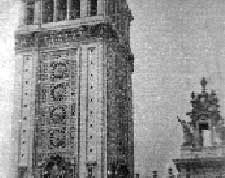 The misleadingly titled Panoramaic View of Electric Tower from a Balloon (1901) extends the Pan-American Exposition honors. It was actually filmed from the tower elevator. Yet the Edison catalog claimed it was done from the basket of a hot air balloon. The misleadingly titled Panoramaic View of Electric Tower from a Balloon (1901) extends the Pan-American Exposition honors. It was actually filmed from the tower elevator. Yet the Edison catalog claimed it was done from the basket of a hot air balloon.
It starts with a ground-level view with people walking by & slowly, slowlly the camera rises into the sky, then comes right back down to earth, the world a yoyo for the stationary camera. Imagining it's a balloon instead of an elevator is kinda fun.
Several more panoramas directed by Porter could be addressed, with some very nice ones shot around New York. Like the audiences of the day, I prefer the story-films, trick films, & jests.
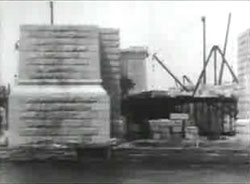 Approaching two & a half minutes, Panorama of Blackwell's Island, N.Y. (1903) is a "phantom ride" on a boat. Blackwell's Island, today called Roosevelt Island, is over a mile & a half long in the East River between Manhattan & Queens.
Approaching two & a half minutes, Panorama of Blackwell's Island, N.Y. (1903) is a "phantom ride" on a boat. Blackwell's Island, today called Roosevelt Island, is over a mile & a half long in the East River between Manhattan & Queens.
We first see a tiny lighthouse at Hallet's Cove at the north point of the island. Jump-cut to a shoreline view of the island's granite wall built by inmates of the island's penitentiary.
Another jump-cut, this time to more trees & architecture, including what looks like a wealthy estate. The estate was known as "the Almshouse," originally the residence of the Blackwell family who formerly owned the island.
You'll spot caissans for the Queensborro Bridge that was not completed until 1908. There's an octagonal building which was an infamous luantic asylum for women, today a park area still called The Octagon.
We see many industrial buildings, the penetentiary & workhouse, charity hospital, & a few trees along the way. It's not a pleasant island, but it's sundry ugly uses is intriguing.
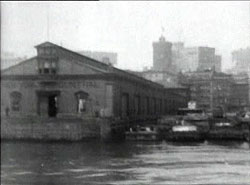 Similar is Panorama Water Front & Brooklyn Bridge from East River (1903), at nearly two & a half minutes. It's another "phantom ride" by boat, this time around the lively tip of Manhattan.
Similar is Panorama Water Front & Brooklyn Bridge from East River (1903), at nearly two & a half minutes. It's another "phantom ride" by boat, this time around the lively tip of Manhattan.
First in view is a large building-pier, i.e., New York Central Pier, with a few boats moored on its immediate right followed by a great many steamships & barges. These are mostly at rest near or around Coenties Slip, though we see one ship building steam, then an anchored tallship with all sails closed.
Still more enclosed warehouse docks & more ships boats between them pass before our eyes, with buildings of a large lower Manhattan business districts visible in the background.
The Ward Line Pier is a particularly large one that reaches very close to the camera, followed immediately by the New York & Cuba Steamship Company dock with its clear signage, followed by a group of tugboats, a couple more docks, then again clearly signed, the two Mallory Lines piers.
We're now at the end of the piers & the camera pans out into the East River, panning the full length Brooklyn Bridge with a couple boats & a barge beneath, closing with a distant view of Brooklyn Heights & a little bit further.
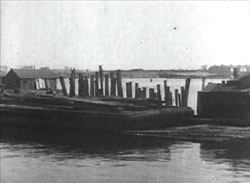 Edwin Porter with his trusty camera mounted on boat or barge was quite busy with h;s "panoramic views" that year, filming also Panorama of Rikers Island, N.Y. (1903).
Edwin Porter with his trusty camera mounted on boat or barge was quite busy with h;s "panoramic views" that year, filming also Panorama of Rikers Island, N.Y. (1903).
Rikers was named for Dutch settler Abraham Rycken who owned the island beginning in 1638. During the Civil War, the island was used for a training camp for African American union soldiers, the first group known as the Anderson Zouaves.
It remained the property of Rycken's descendants until 1888, when it was sold to the city. It was not until the landfill project was nearing completion that a prison was built there (in 1932), so its history was not so miserable when Edwin Porter filmed it, though ironically Porter's film of Blackwell cum Roosevelt island shows the prison that would one day be replaced by Rikers.
The film delivers a two & a quarter-minute journey. The island, in the East River between Queens & the Bronx, was initially only eighty-seven acres. It would eventually be quintupled in size by a massive decades-long landfill project.
The film shows the beginnings of this project, with a steam shovel rising amidst barges of fill dirt, rocks, & questionable garbage for the fill, scooping up the various fill to deposit behind the new sea walls. Check out Porter's New York City Dumping Wharf (1903) to see these barges being loaded.
The camera lingers on its first ugly scene a long while, panning sharply around the artificial sea wall over which the steam-shovel dominates. When the garbage barges are no longer visible, we see a row of pilings driven into the shallows, & the in-progress wall, at this stage more like a fence, with water on both sides.
Far out in the water you'll spot a very few additional pilings which apparently mark the furtehr edge of the enormous area to be filled in.
Soon additional pile-drivers, work sheds, & steam shovels come into view, with more filldirt & garbage barges. At the tail end of the film, a smallish steam train with flatbeds carrying garbage come into view, ready to unload trash shipped in from outside the city.
The enormity of the project is rendered comprehensible, & small wonder it was not finished until the 1930s. It also gives the impression that even before Rikers became the world's largest prison colony, this was already a very, very ugly place.
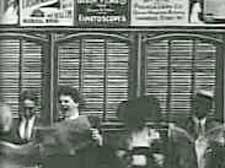 A one-minute gag film is The Unappreciated Joke (1903), recreating a scene of urban life. Shown are three men & a woman seated in a row reading on a street-car, with product placement ads above the windows behind them. A one-minute gag film is The Unappreciated Joke (1903), recreating a scene of urban life. Shown are three men & a woman seated in a row reading on a street-car, with product placement ads above the windows behind them.
One man leaves & a woman takes his seat, but the fellow she sets beside doesn't notice his friend has gone.
Thinking it's still his buddy seated at his side, he starts whacking the woman on the back while laughing & trying to tell her what he's reading in the paper. When he realizes his error, he pulls his straw hat down over his eyes & lowers his head in embarrassment.
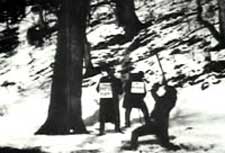 Making a little light fun of Teddy Roosevelt was a little burlesque of Teddy on one of his mountain lion hunting expeditions, in Terrible Teddy, the Grizzly King (1901).
Making a little light fun of Teddy Roosevelt was a little burlesque of Teddy on one of his mountain lion hunting expeditions, in Terrible Teddy, the Grizzly King (1901).
Our presidential hunter runs across the landscape & falls down in the snow, gets up with his rifle, & gazes upward at a treed animal which isn't in the camera's view.
He fires a shot into the tree, then leaps on the ground to grab the fallen prey, a domestic cat, finishing it off with wild blows of his hunting knife while his companions, a photographer & a press agent, record the event that will be reported far & wide as a manly moment.
Teddy then rides out of the forest followed by two companions afoot, & never mind that they all originally arrived afoot. Perhaps it was funnier in its day than it is now, but apparently shooting cats was regarded as funny in those days. The larger point was to use a minor whimsy as a political criticism, in this case of Teddy Roosevelt's easy manipulations of the press.
It was based on two frames of a political cartoon that had appeared in the paper a mere week before the film was made.
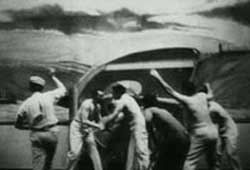 Political films were part of the "news" agenda of kinetoscope entertainment, & an opinion or bias could lend something original to what would otherwise be banal reportage. Political films were part of the "news" agenda of kinetoscope entertainment, & an opinion or bias could lend something original to what would otherwise be banal reportage.
On July 24, 1901, the New York Journal & Advertiser ran a political cartoon titled "Wouldn't It Make You Mad" portraying events that lead up to naval Battle of Santiago de Cuba. The political cartoon criticized Admiral Sampson & condemned him to "a teacup court martial" of public opinion.
The political cartoon had four frames, but one of them was redundant, so there were only three scenes to adapt. The film reproduces the first scene (simultaneously with the redundant third), but invents the second scene (or takes it from the historical event not shown in the cartoon). This would be given to the public in two parts as The Sampson & Schley Controversy (1901).
The second frame of the cartoon became the third & final for the film adaptation, but was copyrighted as a completely separate "sequel," The Sampson & Schley Controversy -- Tea Party (1901). The fourth & final frame of the comic strip had called Sampson a coward, & that was not adapted to the film, being a mite harsh for a tiny entertainment. Reproduced here are the two frames from the newspaper that made it into the film adaptation.
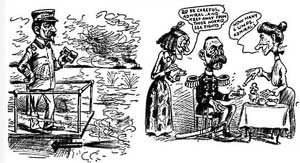 In bringing a political cartoon to life, Porter seems to have taken an objective view of the history of the event rather than retaining the the full bite of the newspaper's visual satire. In bringing a political cartoon to life, Porter seems to have taken an objective view of the history of the event rather than retaining the the full bite of the newspaper's visual satire.
The politics behind both the newspaper cartoon & the film could be the basis of an elaborate essay, but what thrilled me about Porter's Sampson-Schley film(s) is the surprising beauty of the first two highly artificial but amazingly evocative sets for the first of the film pair.
The newspaper artist did not draw prettily, so the pictorial power of the film appears not to have been inspired by the fact of its being adapted from an artist's drawings. That first painted backdrop is lovely, & the manner by which it takes on the illusion of being three-dimensional as the first ship sails around a jetty into the bay, well, its complete artifice resonates with beauty.
This opening tableau could almost be regarded as a precursor to the expressionism of the best classic silent films that were still many years off into the future. And when that model ship fires its cannons, & additional Spanish ships appear distantly entering the harbor, we're in special FX territory quite advanced for the year.
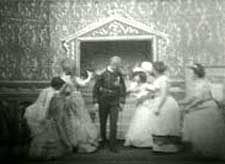 The second sequence shows gunners on deck. The sweeping lines of this set are again aesthetically conceived to convey depth in a painterly manner. The second sequence shows gunners on deck. The sweeping lines of this set are again aesthetically conceived to convey depth in a painterly manner.
Good can also be said of the pantomime acting. We see chiefly the backs of the gunners who have their shirts off, but their intensity of operating the cannon, & their excited body language when they strike a target, is authentic drama, heightened when one of the men takes a bullet & is held by his kneeling commander almost like the pieta.
The third tableau, given as a sequel, seems really to have had a different carpenter crew & set designer, as it has more the standard look seen in other kinescope tableaus such as the closing tableau in Vitagraph's Congress of Nations (1900).
As The Sampson-Schley Controversy -- Tea Part opens, members of a women's club are seen in a dither just before Admiral Sampson arrives, seating himself center stage, flanked by the clubwomen. Cakes & tea are brought by a servant, & so the film closes with nothing more than that.
By keeping the first two episodes separate, it's a film that can be seen for the newsworthiness & heroism without reference to the political cartoon's condemnation of the admiral having a jolly tea part amidst the ladies while soldiers die. The sequel tosses in the criticism of a military hero, though anyone who didn't already know of the controversy, nothing actually critical is explicit.
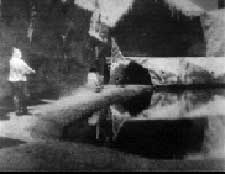 At the Pan-American Exposition in Buffalo, New York, an "Exquimaux" village was created as one of the more interesting features, importing Inuit to display like zoo animals (several aboriginal peoples were similarly displayed, including tribal Indians & Africans).
At the Pan-American Exposition in Buffalo, New York, an "Exquimaux" village was created as one of the more interesting features, importing Inuit to display like zoo animals (several aboriginal peoples were similarly displayed, including tribal Indians & Africans).
It might be demeaning to be moved into a phony exhibit to live even for that little while, but heck, everyone got a free trip to Buffalo.
The hard part for the Inuit must've been pretending they weren't burning up in the heat, dressing like they were in the arctic north (though to be sure, they're rather lightly dressed had they really been home in Labrador, not Greenland as the Exposition pretended). These Inuits put on more or less the same show a couple years later in Louisiana & had to wear the "authentic" snow gear in really hot weather.
These were not just randomly hired Inuit, but entertainers who followed a sort of circuit of Expositions & fairgrounds, bringing their entire families to paricapate.
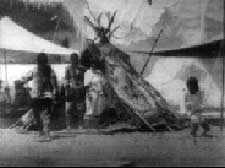 This was a veritable industry that survived at least into the 1950s when plains Indians & subarctic Inuit alike continued to show up at county fairs to put on shows & convince the white rubes that native peoples still lived in igloos or wore gigantic feather bonnets & went "woo-woo-woo." This was a veritable industry that survived at least into the 1950s when plains Indians & subarctic Inuit alike continued to show up at county fairs to put on shows & convince the white rubes that native peoples still lived in igloos or wore gigantic feather bonnets & went "woo-woo-woo."
Esquimaux Village (1901) shows what looks like a concrete bear grotto at some sterile old time zoo. In the background is an odd temporary white plaster structure that certainly doesn't represent an igloo but perhaps a small ice cave.
Inuit run back & forth along a pond-side trail, for no visible purpose except to be running in front of the camera. The Edison catalog said it was a "race" which would be in keeping with the "Esquimaux" three-film set, the other two definitely portraying what pass for aboriginal "games."
But in Esquimaux Village it's just pointless running back & forth on what can't possibly be snow though we're supposed to pretend it is. For climax, sled dogs appear from out of the tunnel pulling a guy on a sled which must have wheels hidden under it since there's no snow. There's also, by the by, no village.
A stagey impressionistic village of haphazard tents provides the backdrop for Exquimaux Leap-frog (1901) showing a slightly more elaborate than average game of leapfrog.
As if to give the impression that the Inuit life is easy with nothing much to get done for survival sake, we're also treated to Esquimaux Game of Snap-whip (1901), in front of what looks like a Plains Indian teepee. It's impossible to tell what the "game" is but two Inuit practice snapping their dog-sled whips, while two other Inuit look on.
The ethnographic value of these scenes is dubious to extreme. This sort of film wasn't really Porter's forte, though it met all the commercial requirements of the time. I've seen photos of this exhibit that did have corners or sectons that looked kind of cool as kitschy crap goes, & Porter failure to find the angels that captured the sense of an Inuit village could rest with him, or with photographer James H. White.
copyright © by Paghat the Ratgirl
|
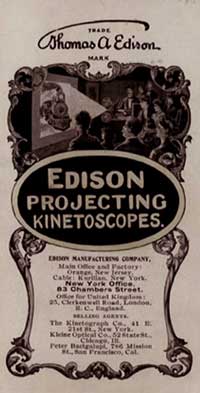






 The misleadingly titled Panoramaic View of Electric Tower from a Balloon (1901) extends the Pan-American Exposition honors. It was actually filmed from the tower elevator. Yet the Edison catalog claimed it was done from the basket of a hot air balloon.
The misleadingly titled Panoramaic View of Electric Tower from a Balloon (1901) extends the Pan-American Exposition honors. It was actually filmed from the tower elevator. Yet the Edison catalog claimed it was done from the basket of a hot air balloon.





 In bringing a political cartoon to life, Porter seems to have taken an objective view of the history of the event rather than retaining the the full bite of the newspaper's visual satire.
In bringing a political cartoon to life, Porter seems to have taken an objective view of the history of the event rather than retaining the the full bite of the newspaper's visual satire. The second sequence shows gunners on deck. The sweeping lines of this set are again aesthetically conceived to convey depth in a painterly manner.
The second sequence shows gunners on deck. The sweeping lines of this set are again aesthetically conceived to convey depth in a painterly manner.
 This was a veritable industry that survived at least into the 1950s when plains Indians & subarctic Inuit alike continued to show up at county fairs to put on shows & convince the white rubes that native peoples still lived in igloos or wore gigantic feather bonnets & went "woo-woo-woo."
This was a veritable industry that survived at least into the 1950s when plains Indians & subarctic Inuit alike continued to show up at county fairs to put on shows & convince the white rubes that native peoples still lived in igloos or wore gigantic feather bonnets & went "woo-woo-woo."